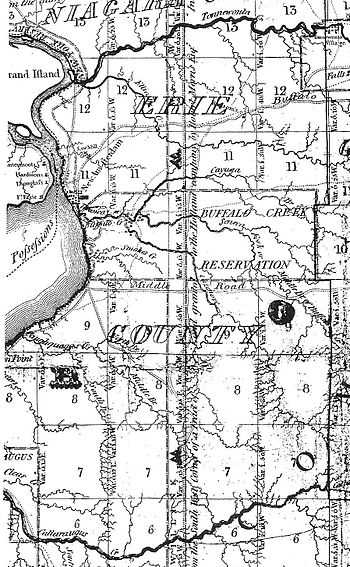Buffalo Creek Reservation

The Buffalo Creek Reservation was a tract of land surrounding Buffalo Creek in the central portion of Erie County, New York.[1][2] It contained approximately 49,920 acres (202.0 km2) of land and was set aside for the Seneca Nation following negotiations with the United States after the American Revolutionary War. Because the Seneca had been allies of the defeated British, the US forced them to cede most of their territory to it. This reservation encompassed much of the present site of the city of Buffalo, New York, as well as its southern and western suburbs.
The Senecas began selling portions of the reservation in the 1820s to members of the Ebenezer Society. In 1838 the United States forced the Seneca to agree to the Treaty of Buffalo Creek, which was part of the Indian Removal policy initiated by the President Andrew Jackson administration. It required the Seneca of western New York to cede all their reservation lands and move west of the Mississippi River, specifically to Wisconsin and Indian Territory (present-day Oklahoma), within five years. After the land sale that required the treaty fell through, the US negotiated a new treaty, which the Senate ratified in 1842. The Buffalo Creek reservation was the only reservation to be dissolved: the Seneca were allowed to keep Cattaraugus, Oil Springs, Allegany and Tonawanda reservations after legal battles in the 1850s fought by Onondaga chief Samuel George and other leaders.[3]
The modern Buffalo Creek Reservation consists of a nine-acre plot of land, which was part of the original reservation. The Seneca developed the Seneca Buffalo Creek Casino on this property, which revenues are used for economic development. The Seneca bought the land from Carl Paladino, who continues to own much of the surrounding land.[4]
Coordinates: 42°51′45″N 78°39′45″W / 42.86250°N 78.66250°W
References
- ↑ Holland Land Company map - circa. 1821
- ↑ Buffalo Historical Society (1920). Publications, Volume 24. Buffalo Historical Society. pp. 109–116. Retrieved 13 July 2012.
- ↑ Hauptman, Laurence (2008). Seven Generations of Iroquois Leadership: The Six Nations Since 1800. Syracuse University Press. ISBN 978-0-8156-3165-1.
- ↑ "Carl Paladino: The accidental candidate", Crain's New York Business, 26 September 2010